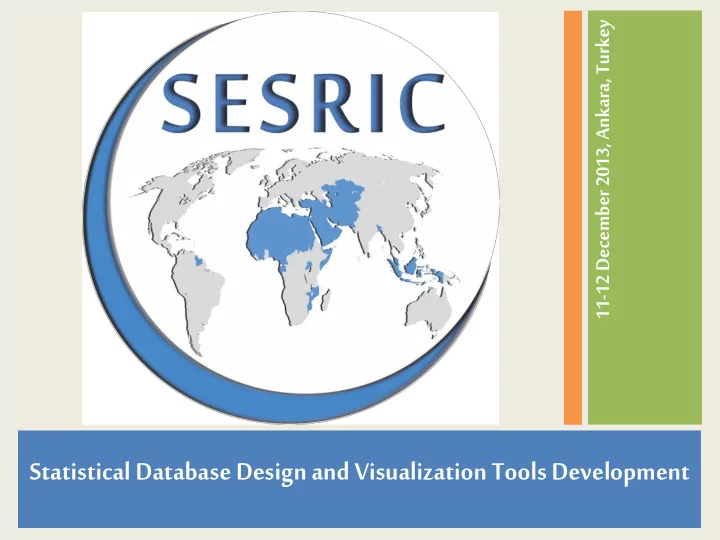

11-12 December 2013, Ankara, Turkey Statistical Database Design and Visualization Tools Development
Statistical Database Experience by SESRIC • SESRIC has a good experience in statistical database application and development of visualization tools. – BASEIND (BAsic Social and Economic INDicators) – OIC Member States in Figures – Statistical Application Development – SESRIC Motion Chart (SMC) – …
Statistical Database Experience by SESRIC (BASEIND) • SESRIC has built a relational database to store the information collected from the national and international statistical sources.
Statistical Database Experience by SESRIC (BASEIND) • 18 categories • 266 socio-economic variables • 57 OIC member countries
OIC Member States in Figures • Presents you with facts and figures from the 57 Member States. After clicking either on the flag or the name of the OIC Member State listed below, the profile of the selected country is displayed. • Uses live data in BASEIND
OIC Member States in Figures
OIC Member States in Figures
Statistical Applications This special software has been developed to extract the full list of BASEIND indicators in which an OIC Member Country is positioned at the very Top or Bottom. This special software has been developed to rank the OIC Member Countries by a selected BASEIND indicator.
OIC Top Bottom Finder
OIC Ranker
Visualization Tools SESRIC Motion Chart (SMC) Module
SESRIC Motion Chart Module • SESRIC Motion Charts (SMC) Module is an interactive and dynamic motion chart generator, producing data visualizations from the indicator sets available in the BASEIND Database. • The SMC Module allows the users to dynamically explore the trends of several indicators over time • The produced charts are time series based bubble charts including two indicators (x and y axes) which can be customized by the user to have either linear or logarithmic scale(s) with alternative bubble sizes (radius) based on a chosen indicator.
Selection of Indicators
Selection of OIC Member Countries
Selection of Time Range and Indicator to be Used as Bubble Size
Sample Data Visualiztion X-Axis: Gross Enrolment Rate in Tertiary Schools Y-Axis: Enrollment Secondary Schools
Sample Data Visualiztion X-Axis: GDP, Per Capita
Sample Data Visualiztion Pie Chart
SMC (SESRIC Motion Chart) Module • Main Design Principles SMC • Technologies Used in the SMC • Features of SMC
Main Design Principles SMC • The charts generated by the SMC Module are rendered within the users’ browser using the Adobe Flash technology. It supports all most every browsers. • The current engine of the motion charts generator is originally developed by the Google Inc. (base framework acquired from Gapminder Foundation). • However, the API provided by Google has some restrictions on the data set available within the BASEIND Database . – Localization is weak, No Arabic Support – Missing data leads to wrong Data Interpolation – Weak Support and maintenance, weak customization – Many bugs
Technologies Used in the SMC • Being developed by SESRIC, the SMC employs the Flex technology as the platform of the module. • Flex is a powerful, open source application framework that allows anyone to easily build traditional applications for Web and Desktop Application.
Technologies Used in the SMC • Flex also allows to develop mobile applications for Apple iOS, Google Android, and RIM BlackBerry Tablet OS devices using the same programming model, tool, and codebase. • Flex integrates with all major back ends including Java, Spring, Hibernate, PHP, Ruby, .NET, Adobe ColdFusion, and SAP using industry standards such as REST, SOAP, JSON, JMS, and AMF.
Technologies Used in the SMC • The SMC Module uses XML (Extensible Markup Language) as the Data Source over HTTP services embedded in Flash with ActionScript. • XML is a markup language that defines a set of rules for encoding documents in a format that is both human-readable and machine-readable. • Any back-end that has the capability of producing XML code can work with the SMC Module to generate data visualisation. • This attribute makes the module to work independently with any kind of database technology.
SMC Structure
Features of SMC • SMC Module has the inflexibility of Google’s API on the issue of handling missing data. • The current SMC uses linear interpolation to handle missing data within indicators. • Thanks to its flexibility, the SMC allows developers to quickly embed any interpolation methods to be deployed.
Networking, Cooperation and Collaboration – A Network can be formed to keep close bond among the OIC NSO`s – Initiate cooperation and activities such as joint projects, experience sharing etc.
SESRIC Motion Chart Module Thank You
Recommend
More recommend